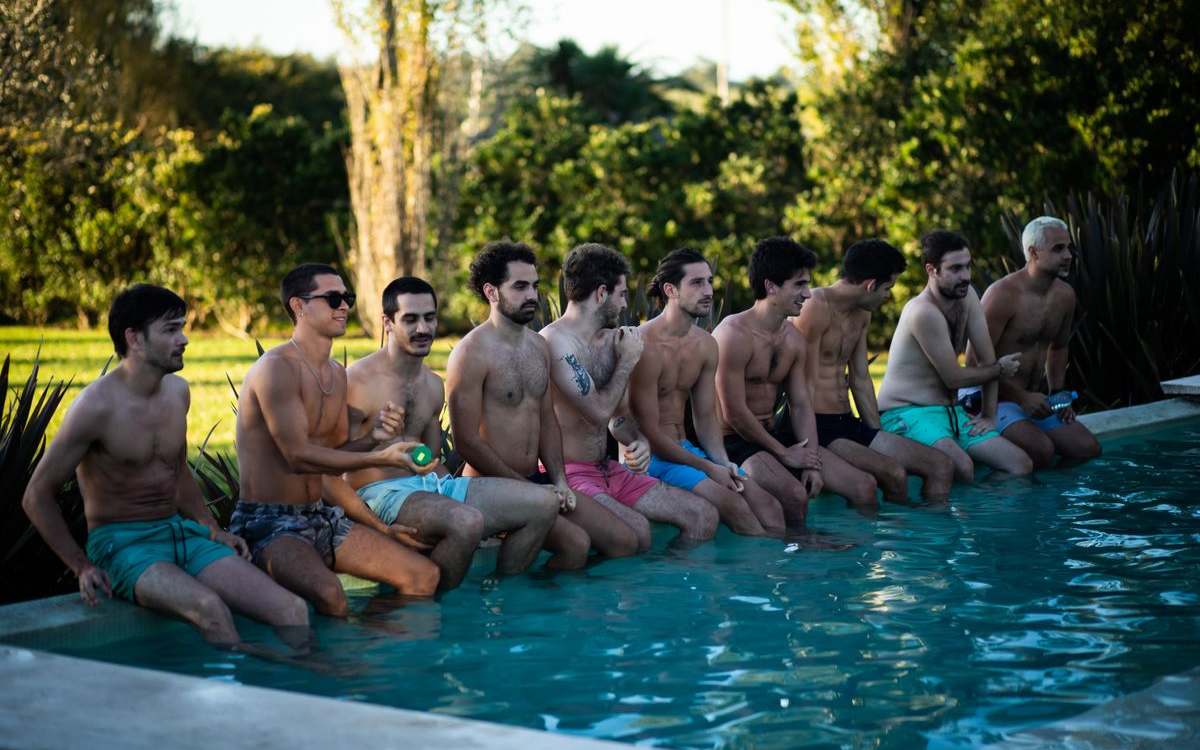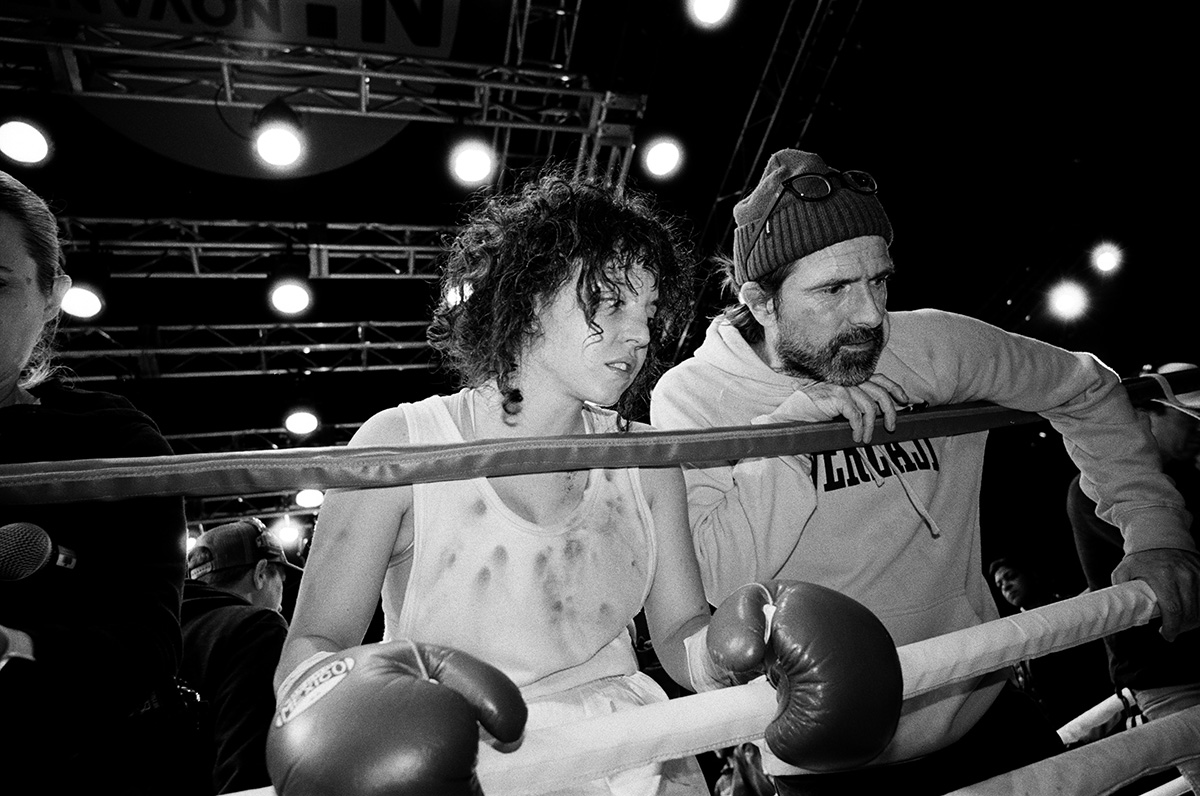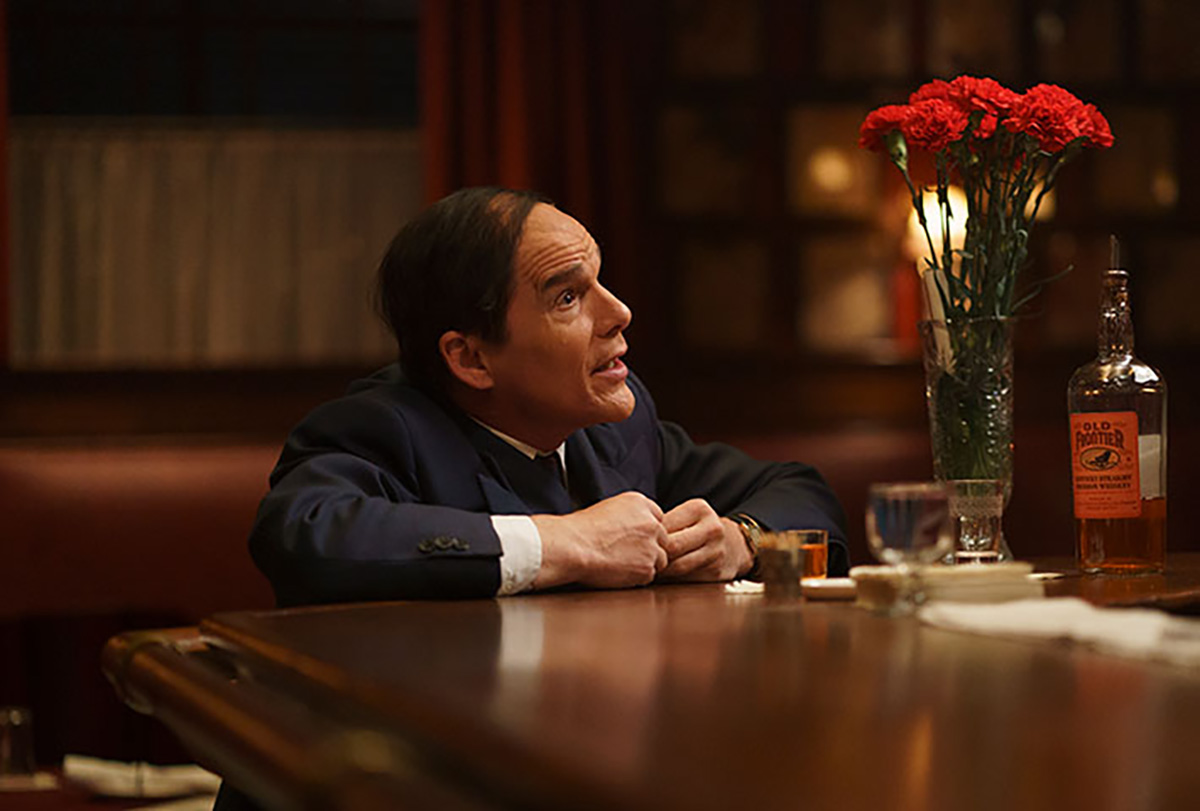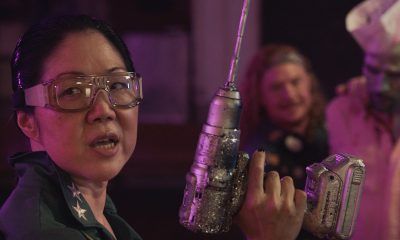Movies
Two new int’l films remind us why Pride is still important
Cinematic proof that homophobia threatens millions around the world

Pride is a time to celebrate, of course, but it’s also a time to remember the struggle, and the fight that continues around the world for the right of LGBTQ people to live freely as they are. This week, the Blade takes a look at two new international releases that remind us that, for many people, homophobia still threatens millions of queer people around the world.
First up, from Italian filmmaker Pasquale Marrazzo comes “The Neighbor” (titled “Hotel Milano” in Italy and available via Digital/DVD from June 6), a supremely crafted, starkly observational drama about a gay couple – Riki (Michelle Costabile) and Luca (Jacopo Costantini) – whose love story is blindsided by violence.
After a gay-bashing incident leaves Luca on life support in a hospital, his family refuses to let Riki come to see him – though Luca’s sister, Rachelle (Luisa Vernelli) is sympathetic enough to keep him informed about his partner’s status as he fights for his life in a medically induced coma. Between pleading with her to intervene on his behalf to Luca’s deeply religious mother (Lucia Vasini) and fending off efforts of help and comfort from his own emotionally-needy mom (Rossanna Gay), he recalls defining moments of their relationship – as well as long-repressed secrets in his personal history – as he tries to come to terms, on his own, with the possibility of unthinkable loss.
In terms of cinematic weight, Marrazzo delivers in style, masterfully using flashbacks to infuse nuance as it moves the story toward what feels like an inevitable conclusion. With a shrewd eye, he hones in on the ways that shame and judgment based on “forbidden” forms of sexuality spread their poison throughout the intimate lives of everyone they touch.
Needless to say, it’s pretty bleak. Something of a spiritual sister to “Brokeback Mountain,” Marrazzo’s harrowing tale spins a harsh indictment of hate and intolerance by leaning into the familiar trope of queer victimhood – a cliché which, sadly, still rings true despite decades of advancement in the worldwide struggle for acceptance – and asking us to endure, along with its protagonists, an unthinkably harsh worst-case scenario in order to illuminate the impact of the intolerance and hate that lie behind it. It’s a movie which, had Hollywood made it, could be about the triumph of love; but devoid of that special American movie magic, and instead steeped in an Italian neo-realism that goes back to the country’s post WWII years, it offers a refreshingly unsentimental “Romeo and Juliet”-esque tale of a love that’s doomed by a mindset based in hate.
With superlative performances from Costabile and Costantini – who make the troubled Riki and the open-hearted Luca, respectively, feel heartbreakingly authentic both as a couple and as individuals – and a uniformly outstanding cast of players on hand to deliver support, it’s a powerful, gripping piece of cinema that avoids pandering to romanticism in order to drive home its message about the tragedies that might be avoided in a world less obsessed with judging others over our own personal beliefs, whether “deeply held” or not.
It’s also mercilessly grim; while it both begins and ends with tenderness and positivity as its two young lovers blissfully enjoy being together in a park, it gives us an uncompromising and sometimes almost unbearably hopeless perspective on the impact a deeply ingrained, traditionally religious cultural bias can have on even the most private lives of anyone who lives outside that rigid norm. For American audiences – especially those fortunate enough to live within urban “bubbles” where the realities of anti-queer prejudice rarely interfere with our ability to live without fear of stigma or worse – that might feel like a bit of throwback; in Marrazzo’s homeland, however, where a swing toward right-wing extremism (championed by nationalist Prime Minister Giorgia Meloni) has found eager support among the country’s hard-coded Catholic population, it might seem more like a defiant plea for compassion and humanity, aimed at opening hearts and minds rather than capitalizing on the self-prophetic doom and gloom of indoctrinated queer self-loathing.
That makes it a highly recommended addition to your Pride month watchlist – but if you’re one of those people who is done with stories that turn our lives into tragedies (and we can’t say we blame you), you might want to give this one a pass despite the important truth it speaks to power.
“Horseplay” (Digital/DVD from June 13), from Argentine director Marco Berger, is hardly a more uplifting film, but it does offer the sex appeal afforded by an impossibly hot cast of young male stars filmed mostly in various stages of undress – an enticement that sounds entirely inappropriate, but gets to the heart of the film’s exploration of (once again) homophobia and its relationship with the distorted idealization of masculinity that drives it.
Set at a luxury villa in the countryside of Argentina, it follows a group of friends who have gathered for a summer holiday getaway, where the mix of drinking, drugs, and youthful testosterone results in predictably crass but relatively harmless hijinks and a few embarrassing photos, mostly driven by mockingly homophobic insinuation and ridicule; it’s all in good fun – just bros being bros, right? – at first, but as the week progresses, underlying insecurities, secrets, jealousies, and other deep-rooted by-products of toxic masculinity begin to bubble closer to the surface, and the pressure under the boys’ high-spirited, boundary-crossing hedonism begins to build toward something far less innocent.
To give away more detail would undo the movie’s carefully layered revelation of detail, which makes for a fascinating study of immature masculinity and the not-so-subtle social coercion that perpetuates a rigid, mostly heterosexual norm. Berger’s point, underscored by the film’s blatantly gay “male gaze” and its characters’ seeming obsession with all things “homo” as a running theme in their various harassments of each other, seems to be that the most virulent homophobia comes in people who are hiding their own queerness from the world – and probably themselves, too. It’s scarcely a new concept, but in a world where anti-LGBTQ bigotry seems to be working overtime to assert its prejudices against anyone who loves differently, it’s a helpful reminder that our enemies are motivated by small-minded fear, whatever ideological rhetoric or religious dogma they may spout at us to justify it.
Unfortunately, though Berger employs a fly-on-the-wall aloofness in his film’s scenario, much of it feels forced, weighted to lead us to a desired conclusion. The casual intimacy of ostensibly straight companions seems a little too intimate, their eagerness to “feign” sexual attraction for each other a little too eager; further undermining the effect, the large number of characters in the ensemble makes it occasionally difficult to keep track of who they are and what relationships they have with each other.
Even so, its insight into hyper-hypermasculinity and its correlation with social condition around sex and gender norms rings true, even if the same cannot always be said of what we see on the screen. And although it may, like “The Neighbor,” be a little too dark for some, it offers up plenty of “eye candy” by way of compensation – so why not enjoy it?
It is Pride month, after all.
Movies
Sydney Sweeney embodies lesbian boxer in new film ‘Christy’
Christy Martin’s life story an inspirational tale of survival

For legendary professional boxer Christy Martin, never in a million years did she expect to see the riveting story of her rapid rise to fame onscreen.
“When somebody first contacted me about turning my life into a movie, I thought they were joking,” Martin said at a recent Golden Globes press event for her movie, “Christy.”
“I was so afraid that my life would be as I call it, Hollywoodized.”
Martin was put at ease once she saw how committed co-screenwriters Mirrah Foulkes, and Australian filmmaker David Michôd were to the material, and how relentless actress Sydney Sweeney was to accurately portray her.
“Mirrah was very fair to me and treated me great on the paper … I feel like this is the most powerful group that could ever come together to tell my story,” she acknowledged.
In “Christy,” viewers see Martin’s combative spirit, in her ongoing quest to win each fight. Under her demanding coach turned manager-husband Jim Martin (played by Ben Foster), Christy is fearless in the boxing ring, yet increasingly troubled as she deals with the pressure of her mother, sexual identity issues, drugs, and a physically abusive marriage that almost ended in death.
“It’s crazy to see anybody, but especially Syd, become me,” she told the Los Angeles Blade. “It’s overwhelming! A little much for a coal miner’s daughter from a small town in southern West Virginia.”
For Sweeney, who is also a producer on the film, playing the courageous lesbian boxer has been a life-changing experience. “This is the most important character I have ever played. It’s the most important story I have ever told or will tell. It’s an immense honor to bring her to life.”
To become Martin, Sweeney worked hard to absorb as much information on her as possible.
“I had the real Christy, and then I had years and years of interviews and fight footage and her book and her documentary on Netflix that I was able to pull from. I like to build books for my characters, to create their entire life, from the day they’re born until the first time you meet them onscreen. So just kind of filling out the entire puzzle of Christy here.”
Sweeney said the many scenes where Martin’s mom couldn’t accept she was gay were immensely challenging to be a part of.
“That was probably one of the hardest scenes for me,” Sweeney noted. “I have very supportive parents, and I can’t imagine what it would be like to not have your mom or dad to turn to ask for help or guidance or just need support. So it was a very difficult scene to process.”
Equally challenging was the rigorous process Sweeney went through in order to become Martin in the movie.
“It was a huge physical transformation for me. I trained for two-and-a-half months before we even started filming, and I put on 35 pounds for the role, so it was a big transformation.”
As difficult as it was to deal with a film that dives into domestic violence, Sweeney was able to shake the character off when she was done at the end of each day.
“I have a rule for myself where I don’t allow any of my own thoughts or memories into a character. So when the moment they call ‘cut,’ I’m back to being Syd, and I leave it all in the scene, and that’s the story that I’m telling. Otherwise I’m just me; so I go home when I’m me.”
Martin hopes that audiences leave the theater with a sense of faith.
“I think we showed a path of how to get out of any situation that you might be in. And also, it’s very important to be true to you. Sometimes that takes a while — it took me a little while — but I’m happy to be true to me. And that’s what we want; the whole story is about being who you are.”
Sweeney would love viewers to walk away and demand to be “Christy Strong.”
“I hope that they want to be kind and compassionate to others around them, and be that helping hand. Christy’s story is singular, and yet her story of triumph, survival and continuation, supports those who are in experiences of domestic violence behind closed doors. She is one of the great champions.”
Sweeney loves that Martin is also a great advocate of new boxing talent. “That spark of life is something that I think at the end of the day, ‘Christy’ is about– it’s the spark to keep going and be who you are proudly.”
Movies
Superb direction, performances create a ‘Day’ to remember
A rich cinematic tapestry with deep observations about art, life, friendship

According to writer/director Ira Sachs, “Peter Hujar’s Day” is “a film about what it is to be an artist among artists in a city where no one was making any money.” At least, that’s what Sachs – an Indie filmmaker who has been exploring his identities as both a gay and Jewish man onscreen since his 1997 debut effort, “The Delta” – told IndieWire, with tongue no doubt firmly planted in cheek, in an interview last year.
Certainly, money is a concern in his latest effort – which re-enacts a 1974 interview between photographer Peter Hujar (Ben Whishaw) and writer Linda Rosenkrantz (Rebecca Hall), as part of an intended book documenting artists over a single 24-hour period in their lives – and is much on the mind of its titular character as he dutifully (and with meticulous detail) recounts the events of his previous day during the course of the movie. To say it is the whole point, though, is clearly an overstatement. Indeed, hearing discussions today of prices from 1974 – when the notion of paying more than $7 for Chinese takeout in New York City seemed outrageous – might almost be described as little more than comic relief.
Adapted from a real-life interview with Hujar, which Rosenkrantz published as a stand-alone piece in 2021 (her intended book had been abandoned) after a transcript was discovered in the late photographer’s archives, “Peter Hujar’s Day” inevitably delivers insights on its subject – a deeply influential figure in New York culture of the seventies and eighties, who would go on to document the scourge of AIDS until he died from it himself, in 1987. There’s no plot, really, except for the recalled narrative itself, which involves an early meeting with a French journalist (who is picking up Hujar’s images of model Lauren Hutton), an afternoon photo shoot with iconic queer “Beat Generation” poet/activist Allen Ginsburg, and an evening of mundane social interaction over the aforementioned Chinese food. Yet it’s through this formalized structure – the agreed-upon relation of a sequence of events, with the thoughts, observations, and reflections that come with them – that the true substance shines through.
In relaying his narrative, Hujar exhibits the kind of uncompromising – and slavishly precise – devotion to detail that also informed his work as a photographer; a mundane chronology of events reveals a universe of thought, perception, and philosophy of which most of us might be unaware while they were happening. Yet he and Rosenkrantz (at least in Sachs’ reconstruction of their conversation) are both artists who are keenly aware of such things; after all, it’s this glimpse of an “inner life,” of which we are rarely cognizant in the moment, that was/is their stock-in-trade. It’s the stuff we don’t think of while we’re living our lives: the associations, the judgments, the selective importance with which we assign each aspect of our experiences, that later become a window into our souls – if we take the opportunity to look through it. And while the revelations that come may occasionally paint them in a less-than-idealized light (especially Hujar, whose preoccupations with status, reputation, appearances, and yes, money, often emerge as he discusses the encounter with Ginsberg and his other interactions), they never feel like definitive interpretations of character; rather, they’re just fleeting moments among all the others, temporary reflections in the ever-ongoing evolution of a lifetime.
Needless to say, perhaps, “Peter Hujar’s Day” is not the kind of movie that will be a crowd-pleaser for everyone. Like Louis Malle’s equally acclaimed-and-notorious “My Dinner With Andre” from 1981, it’s essentially an action-free narrative comprised entirely of a conversation between two people; nothing really happens, per se, except for what we hear described in Hujar’s description of his day, and even that is more or less devoid of any real dramatic weight. But for those with the taste for such an intellectual exercise, it’s a rich and complex cinematic tapestry that rewards our patience with a trove of deep observations about art, life, and friendship – indeed, while its focus is ostensibly on Hujar’s “day,” the deep and intimate love between he and Rosenkrantz underscores everything that we see, arguably landing with a much deeper resonance than anything that is ever spoken out loud during the course of the film – and never permits our attention to flag for even a moment.
Shooting his movie in a deliberately self-referential style, Sachs weaves the cinematic process of recreating the interview into the recreation itself, bridging mediums and blurring lines of reality to create a filmed meditation that mirrors the inherent artifice of Rosenkrantz’s original concept, yet honors the material’s nearly slavish devotion to the mundane minutiae that makes up daily life, even for artists. This is especially true for both Hujar and Rosenkrantz, whose work hinges so directly to the experience of the moment – in photography, the entire end product is tied to the immediacy of a single, captured fragment of existence, and it is no less so for a writer attempting to create a portrait (of sorts) composed entirely of fleeting words and memories. Such intangibles can often feel remote or even superficial without further reflection, and the fact that Sachs is able to reveal a deeper world beyond that surface speaks volumes to his own abilities as an artist, which he deploys with a sure hand to turn a potentially stagnant 75 minutes of film into something hypnotic.
Of course, he could not accomplish that feat without his actors. Whishaw, who has proven his gifts and versatility in an array of film work including not only “art films” like this one but roles from the voice of Paddington Bear to “Q” in the Daniel Craig-led “James Bond” films, delivers a stunning performance, carrying at least 75% of the film’s dialogue with the same kind of casual, in-the-moment authenticity as one might expect at a dinner party with friends; and though Hall has less speaking to do, she makes up for it in sheer presence, lending a palpable sense of respect, love, and adoration to Rosenkrantz’s relationship with Hujar.
In fact, by the time the final credits role, it’s that relationship that arguably leaves the deepest impression on us; though these two people converse about the “hoi polloi” of New York, dropping legendary names and reminding us with every word of their importance in the interwoven cultural landscape – evoked with the casual air of everyday routine before it becomes cemented as history – of their era, it’s the tangible, intimate friendship they share that sticks with us, and ultimately feels more important than any of the rest of it. For all its trappings of artistic style, form, and retrospective cultural commentary, it’s this simple, deeply human element that seems to matter the most – and that’s why it all works, in the end. None of its insights or observations would land without that simple-but-crucial link to humanity.
Fortunately, its director and stars understand this perfectly, and that’s why “Peter Hujar’s Day” has an appeal that transcends its rarified portrait of time, place, and personality. It recognizes that it’s what can be read between the lines of our lives that matters, and that’s an insight that’s often lost in the whirlwind of our quotidian existence.
Movies
Queer Broadway icon gets stellar biopic treatment in ‘Blue Moon’
Ethan Hawke delivers award-worthy performance as Lorenz Hart

Even if you’ve never heard the name Lorenz Hart, chances are high you’ve heard some of his songs.
A giant of early 20th century Broadway songwriting, he was a lyricist whose complex blend of wit and wistful romanticism – mostly set to music by longtime composing partner Richard Rodgers – became a significant part of the “Great American Songbook,” performed and recorded by countless musical artists in the decades since. Yet despite his success, happiness eluded him; depression and alcoholism eventually hobbled his career, and he died in 1943 – aged only 47 – from a case of pneumonia he caught after passing out in the rain in front of his favorite bar.
His tragic story might seem an odd fit for a screen treatment from maverick director Richard Linklater, but his latest film – “Blue Moon” in theaters as of Oct. 24 – delivers exactly that. It crafts a mostly speculative and highly stylized portrait of Hart (portrayed in a tour-de-force by longtime Linklater muse Ethan Hawke) on a night that was arguably the lowest point in his professional career: the opening night of “Oklahoma!” – the soon-to-be smash hit composed by Rodgers (Andrew Scott) with new partner Oscar Hammerstein III (Simon Delaney) after their two-decade partnership had been tanked by his personal struggles.
In Robert Kaplow’s theatrically crafted screenplay, Hart shows up early for the post-opening celebration – held, of course, at Broadway’s legendary meeting place, Sardi’s – to hold court with the bartender (Bobby Cannavale) and a young hired piano player (Jonah Lees) while steeling his nerves with a few shots of the whiskey he has sworn to avoid. He’s not there to support his old colleague, however; there’s too much resentment swirling inside him for that. Rather, he’s there to connect with 20-year-old college student Elizabeth (Margaret Qualley), whom he has taken on as a protege – and with whom he has convinced himself he is in love, despite the homosexual inclinations that are mostly an “open secret” within his circle of Broadway insiders.
Constructed as a real-time narrative that follows Hart over the course of the evening, Kaplow’s script could almost be described as a monologue – with interruptions, of course – by the songsmith himself; aided by Hawke’s fearlessly unsentimental performance, the film’s presentation of Hart – a queer man grappling with his own self-loathing in a deeply homophobic era – is almost brutal in its exploration of his emotional and psychological landscape. He has walked a thin line for most of his life, alternately hiding and flaunting his inner truth for decades to navigate his world, and the strain has taken its toll; once heralded as one of Broadway’s brightest talents, his reputation has been ravaged by rumor, and he occupies his time by escaping his loneliness through self-denial and liquor. He’s become that guy at the bar who regales you with larger-than-life stories while peppering them with barely concealed bitterness and regret; you can’t help but feel empathy for him, but you’d love to politely extract yourself from the situation at the first opportunity.
There’s something relatable about that situation – from both perspectives – and that’s what keeps “Blue Moon” from becoming insufferable. It’s the kind of movie that makes us cringe, not over the pathetic behavior of its leading character but in anticipation of the next uncomfortable development that’s sure to come as a consequence. He’s a seasoned raconteur, with a polished wit and a prodigious skill with language, and we find ourselves pulling for him both in spite and because of the sense of manic desperation we can feel behind his words.
It’s that almost-grudging empathy we feel for him that gives “Blue Moon” a sense of humanity in the face of what might otherwise seem a relentlessly bleak character study, and keeps us from judging Hart’s impulses toward self-delusion and self-destruction too harshly; and in the end, Linklater’s biopic leaves us with a perspective on his life that emphasizes the legacy he left behind – the poignant lyrics that bespoke an unfulfillable longing for love and connection – and the lasting influence he cast over the generations that succeeded him.
To underscore the latter, the movie imagines a few fortuitous encounters during the festivities at Sardi’s, in which Hart unknowingly drops nuggets of inspiration for such future icons as author E.B. White and a very young Stephen Sondheim. The meetings may or may not not be flights of fancy, but they convey the lasting impact of Hart’s creative contributions in a way that not only feels truthful in spirit but provides some amusing “Easter Egg” moments for buffs of Golden Age Broadway-and-Hollywood lore.
In fact, it should be said that “Blue Moon,” despite the underlying melancholy and the squirm-in-your-seat discomfort that hovers around its edges, is a thoroughly entertaining film; constructed like a play, shot in a style that evokes the cinema of the era (with ongoing references to “Casablanca” to underscore the connection), and wrapped in the nostalgic glow of old Manhattan in its elegant heyday, it bubbles with the kind of wryly sophisticated humor that marked so much of Hart’s own work and thrills us with the feelings it sparks within us as it goes.
For that, we must again point to Hawke’s award-worthy performance as the core element; though he accomplishes a physical transformation into the short-and-balding Hart, and masterfully captures his flamboyant personality, it’s the actor’s understanding of the songwriter’s inner landscape that gives the movie its heart, soul, and painfully human perspective.
Even so, it’s a movie with an entire cast’s worth of superb performances. There’s Scott’s carefully measured Rodgers, balancing genuine friendship with the frustrated impatience of navigating a strained relationship in public. Qualley walks a similar tightrope as the object of Hart’s misguided affections, charming us with authentic fondness and diplomatic compassion, and Cannavale provides a solid ground of streetwise wisdom as the bartender who might be his best friend. Patrick Kennedy’s E.B. White, bringing a welcome note of respect and insight, is also a standout.
Yet while the acting in “Blue Moon” may be excellent across the board, it’s Linklater’s direction that drives his cast’s work and ties it all together; a proven chameleon behind the camera, he embraces the theatrical structure of the screenplay with a perfectionist’s aesthetic, and indulges his fascination with time by encapsulating the portrait of a man’s entire life into the observations that can be gleaned from a single night. More importantly, perhaps, he honors his subject by refusing to define Hart’s sexuality to fit modern sensibilities. We can draw whatever conclusions we want, but in the end we have no reason to reject the songwriter’s description of himself as “ambi-sexual” – even though, with its undercurrent of jealousy between two ex-partners, it’s hard not to take note of some very gay implied subtext.
In the end, Hart’s sexual “label” is irrelevant; his loneliness is what matters, the longing to love – and to be loved – which we all share, regardless of our sexual makeup.
It’s the tragic beauty of that universal pang that comes through in all of the timeless lyrics that Lorenz Hart wrote, and it comes through in Linklater’s excellent movie, too.
-

 U.S. Supreme Court4 days ago
U.S. Supreme Court4 days agoSupreme Court rejects Kim Davis’s effort to overturn landmark marriage ruling
-

 District of Columbia4 days ago
District of Columbia4 days agoCapital Pride files anti-stalking complaint against local LGBTQ activist
-

 Politics1 day ago
Politics1 day agoPro-trans candidates triumph despite millions in transphobic ads
-

 Dining4 days ago
Dining4 days agoSpark Social House to start serving alcohol



















